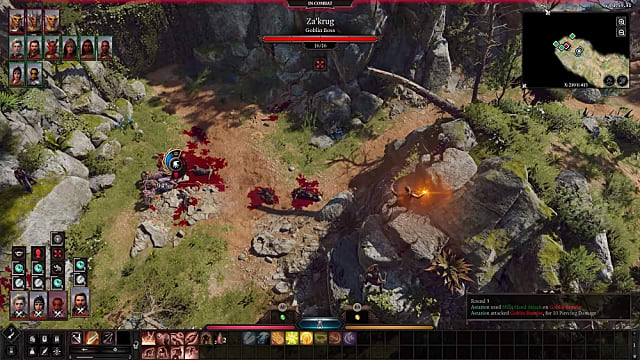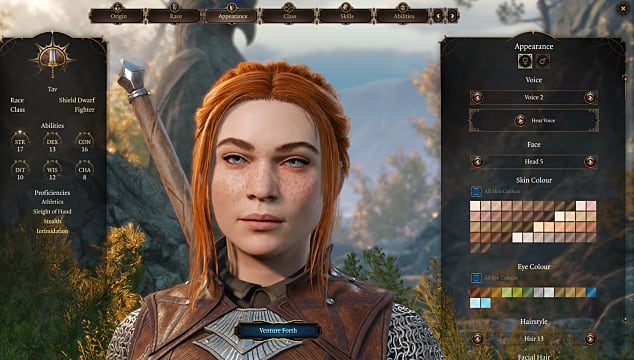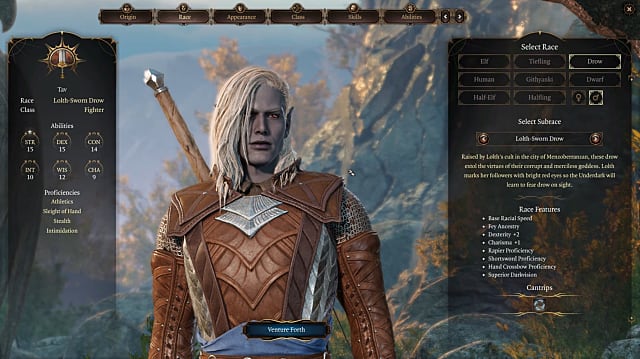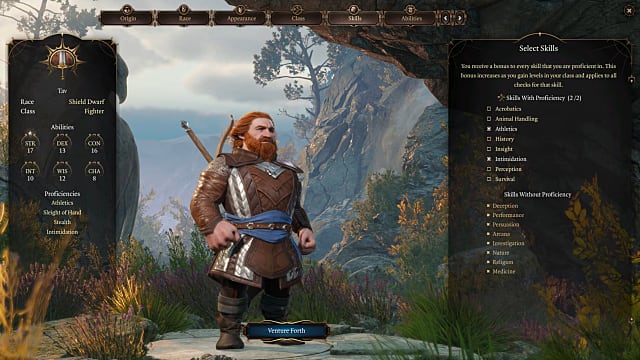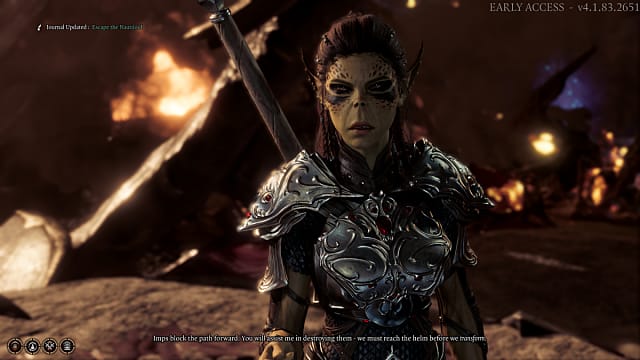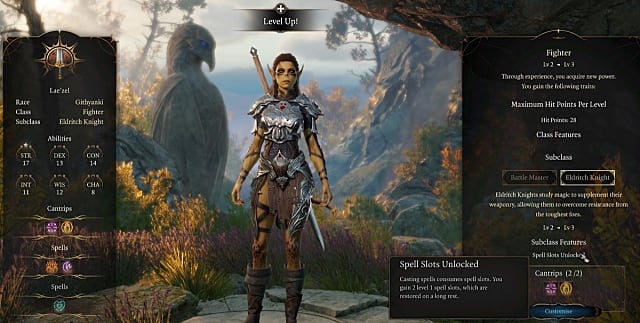The fact of the matter is that in Dungeons & Dragons 5th Edition (5E), which Baldur’s Gate 3 is directly based on, Fighters are essential. They dish out tons of melee damage, are great at keeping enemies occupied, and can usually serve as the stone wall at the tip of the spear in a big fight.
Good fighters can be the difference between life and death on the unforgiving battlefields of the Forgotten Realms.
After spending lots of time with Baldur’s Gate 3, I’ve rounded up these tips on creating the best Fighter build, whether that be your own custom creation or Lae’zel, the Companion character fighter you can recruit early on.
Baldur’s Gate 3 Best Fighter Build Guide
When making a character in Baldur’s Gate 3, you have to make six basic core choices outside of their physical appearance:
Race/Subrace Class/Subclass Origin + Background Skills Abilities Feats
Sometimes a build will include Spells too, but in the case of a Fighter, probably not — at least not at first.
The most important thing to keep in mind when playing a D&D 5E game like Baldur’s Gate 3 is that there is no wrong way to play it. It’s entirely possible to get through much of the game without even engaging in combat if you’re good enough at stealth and charismatic enough to beguile NPCs.
Treating it like a tabletop RPG is a great mindset for success and the same applies to building a character.
That being said, Fighters tend to excel primarily at, well…fighting. They’re named after the concept, after all.
Baldur’s Gate 3 Fighter Class Tips
When it comes to playing a Fighter, the best advice is to keep it simple and not overcomplicate things. Other classes might be flashier with spells, fancy moves, or bursts of damage here and there, but Fighters are all about reliability and consistency.
Position your Fighter between the enemy and the rest of your party and focus on dolling out reliable damage. Make enemies focus on you so the Rogue or Ranger can slip around behind for backstab damage. Shove enemies off of cliffs using your high Strength or jump up onto ledges to chase down and pressure ranged enemies.
Strength-based Fighters should be aggressive and relentless, whereas Dexterity-based Fighters can fight from afar when beneficial or get up close as needed relying on high Dexterity to avoid damage.
This class isn’t very exciting at first, but once you hit Level 3, it starts to get a lot better. This is when you get your subclass and can start attacking more than once per turn and using special class abilities.
Baldur’s Gate 3 Fighter Starting Class Features
In Baldur’s Gate 3 (and by extension, Dungeons & Dragons 5E), each class has a starting set of proficiencies and skills known as Class Features. Your Race and Background (and in the future, Origin) will include specific Features as well.
As it stands, every Fighter in Baldur’s Gate 3 regardless of race gets:
Strength Saving Throw Proficiency Constitution Saving Throw Proficiency Light Armor Proficiency Medium Armor Proficiency Heavy Armor Proficiency Shield Proficiency Simple Weapon Proficiency Martial Weapon Proficiency
Best Races for Strength-Based Fighter Builds
There are lots of races and subraces in Baldur’s Gate 3 already, even in the very first chunk of Early Access, with 16 options. Notably, an obscure race not listed in the base Player’s Handbook is already available, the Githyanki, whereas well-known default races such as Gnome and Dragonborn are not — yet.
When picking a race for a Fighter, the most important stat to look for is Strength, in almost all cases. This is the stat that affects your damage with most melee weapons, specifically the more powerful martial class of weapons.
A Strength-based Fighter will likely use heavy weapons, or one-handed weapons with a shield, while wearing either medium or heavy armor. Strength-based Fighters can also carry more weight and jump further.
The best races to pick for a Strength-based Fighter build are:
Shield Dwarf
If you intend on being a very tanky, up-close Fighter that uses a shield and one-handed weapon, Shield Dwarf is a great choice. You’ll get +2 Strength as your subrace bonus, as well as +2 Constitution for being a Dwarf in general, which increases your hit points.
There’s also Dwarven Resilience, giving advantage on saving throws for poison and resistance to poison damage, darkvision to see in the dark, and proficiencies with:
Battleaxes Handaxes Light Hammers Warhammers Light Armor (already included as a Fighter) Medium Armor (already included as a Fighter)
Githyanki
Githyanki is another solid race choice for a Strength-based Fighter build because it includes a base +2 Strength bonus, +1 Intelligence bonus, which is helpful if you get Spells in the future and for saving throws, the nifty Mage Hand cantrip, and adds proficiencies with:
Shortswords Longswords Greatsword Light Armor (already included as a Fighter) Medium Armor (already included as a Fighter)
Anything other than those two races puts you at a disadvantage with a Strength-based Fighter build.
Best Races for Dexterity-Based Fighter Builds
Alternatively, you may not want to play a Strength-based Fighter. Instead, you might want to be a bit lighter on your feet with more versatility while still being able to dish out big damage.
Dexterity-based Fighters aren’t as tanky and usually have lower AC (Armor Class, which determines the chance of you getting hit by most melee attacks). But they can make great bow users that also know their way around simple melee weapons up close, like a more durable Ranger or Rogue.
Dexterity-based Fighters also typically go sooner in the turn order due to a higher initiative modifier.
The best races to pick for a Dexterity-based Fighter build are:
Drow (either subrace)
The Drow make excellent Dexterity-based Fighters because both subraces have the same Race Features. You get +2 Dexterity, +1 Charisma, superior darkvision, Fey Ancestry granting advantage against being Charmed, and Sleep-magic doesn’t work on you. Plus, you have the following proficiencies:
Rapiers Shortswords Hand Crossbows
Wood Elf
Of the two types of pure Elf races, the Wood Elf is the best Dexterity-based Fighter build option. Not only does it get a +2 Dexterity bonus and +1 Wisdom bonus, but it also has Fey Ancestry just like the Drow, Keen Senses granting proficiency in Perception, darkvision, Fleet of Foot increasing movement range by 5ft., Mask of the Wild granting proficiency on Stealth checks, and additional proficiencies with:
Shortswords Longswords Shortbows Longbows
Anything other than those two races puts you at a disadvantage with a Dexterity-based Fighter build.
Baldur’s Gate 3 Fighter Primary Abilities
You can manually allocate your Fighter’s starting abilities out of the following:
Strength Dexterity Constitution Intelligence Wisdom Charisma
Your two most important stats as a Fighter in Baldur’s Gate 3 are first and foremost either Strength or Dexterity — whichever path you decided for your Race earlier since that determines your damage and chance to land attacks — followed by Constitution second, which determines your amount of hit points.
Focus your stats that way so you won’t accidentally “break” your Baldur’s Gate 3 Fighter build and render them useless in combat.
That said, these stats aren’t the only “flavor” of interaction outside of combat, and you should absolutely grant extra points to other abilities based on the type of character you’d like to roleplay.
If you want to be fearsome and intimidating, or persuasive, beefing up Charisma can help for conversations for example.
Best Fighter Skills
Baldur’s Gate 3 Fighters can manually choose two skills that they are proficient with, in addition to any proficiencies given by their chosen race and background. Those are a darkened orange color to show they’re locked in already.
All Fighters should strive to take Athletics as a proficiency to complement their role in the party, but everything else is mostly up to you. These are the skills you have to choose two additional proficiencies from; I’ve bolded some of the options I’d consider taking personally:
Acrobatics Athletics Deception Insight Intimidation Investigation Perception Performance Persuasion Sleight of Hand Stealth
Proficient skills gain bonuses that scale with your level. At first, this equates to a direct +2 modifier in that skill, making skill checks much easier in dice rolls.
Skills automatically receive a +1 modifier for every two points allocated to their corresponding ability, with 10 (+0) as the baseline. Skills also receive a -1 modifier for associated skills whenever an ability stat decreases to 9 or lower.
For example, a Fighter who has 9 points in Charisma has an immediate -1 modifier to Intimidation, whereas a Fighter who has 16 points in Strength has an immediate +3 modifier to Athletics.
Note that Githyanki can choose up to three skills instead of two and can become proficient in skills that are normally unavailable to Fighters.
Best Fighter Backgrounds
When choosing a background, you’re basically choosing a starting point for your Baldur’s Gate 3 Fighter’s story, including two extra skill proficiencies.
Best Strength-Based Fighter Background
Soldier is an excellent choice for a Strength-based Fighter with proficiencies in both Athletics and Intimidation, likely skill checks you’d want to excel at here.
Alternatively, Sailor grants Athletics, too, but swaps Intimidation for Perception.
Then there’s Outlander, granting proficiencies in both Athletics, once again, and Survival.
Best Dexterity-Based Fighter Background
Urchin is a great option, with proficiencies in both Stealth and Sleight of Hand, if you want to go a sneakier route with your Fighter.
Criminal is another decent option for this type of fighter because it also grants proficiency in Stealth and includes Deception as well.
Best Well-Rounded Fighter Background
Fighter is a flexible class, and there are some Origins that would work well for either a Strength-based Fighter or a Dexterity-based Fighter, such as the Guild Artisan. This background gives you proficiency in both Insight and Persuasion.
There’s also the Folk Hero background, which provides proficiencies in Survival and Animal Handling.
Baldur’s Gate 3 Fighter Subclasses
The Fighter in Baldur’s Gate 3 has two subclasses to pick from at Level 3, which each offer very different paths for your character. They may as well be two entirely different classes in and of themselves.
Battle Master
First up is the Battle Master, my preferred option personally. If you intend on staying a melee Fighter, then this is the best choice to make.
The Battle Master gets a new feature called Superiority Die. You can “spend” these during combat to use unique, special abilities that can heal, do extra damage, and more. At first, you get four Superiority Die, which recharge after a Short Rest.
You get to pick three options out of four choices to take as your Superiority Die actions:
Rally: Grants 8 temporary hit points to yourself or a target. Menacing Attack: Adds frightening the opponent on a successful hit. Pushing Attack: Shoves an enemy after doing damage on a successful hit. Riposte: If an enemy misses a melee attack, you retaliate with bludgeoning damage.
Eldritch Knight
The other Fighter subclass is squarely on the opposite end of the spectrum: Eldritch Knight. If you imagine Paladins (not a class in the game yet, but will presumably be added) as a combination of Clerics and Fighters, then think of the Eldritch Knight as a combination of Wizards and Fighters.
You get to choose from a small selection of Level 1 Cantrips (unlimited uses, just like any other base action) and spells (each spell spends a spell slot). Adding magic spells to a Fighter can be very powerful, depending on the route you take.
If you’re a Dexterity-based ranged fighter, then offensive ranged spells might make sense. But a melee fighter might prefer defensive spells or up-close offensive spells.
You can see a full spell list here, but my suggestions would be definitely selecting Dancing Lights to help when enemies are obscured in darkness and then picking another Cantrip, such as True Strike to get advantage on attack rolls more often, Blade Ward for added resistance, or Fire Bolt since lighting things on fire is always useful.
From the Spells list, Magic Missile is a great choice since it can’t miss and the rest is entirely up to you.
Regardless of which subclass you pick, you’ll also get a three-times distance transmutation Jump spell as well.
That wraps up our guide on how to build the best fighter in Baldur’s Gate 3. There are lots of ways to play a Fighter, but these are the suggestions we feel work the best. If you’d like more insight into playing Baldur’s Gate 3, take a look at our other tips and guides content for other class build guides and more. If you found this build guide helpful, please consider giving it a share!

